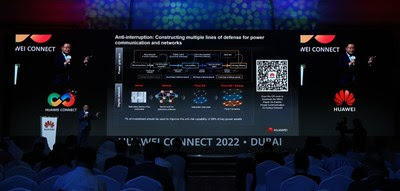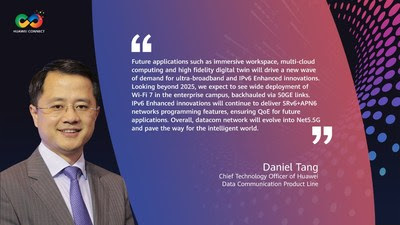DUBAÏ, UAE, 14 octobre 2022 /PRNewswire/ — À l’occasion de HUAWEI CONNECT 2022 à Dubaï, Huawei a publié le livre blanc sur les réseaux de conduite autonome L3.5 pour les centres de données, en collaboration avec la section IEEE-UAE et les précurseurs de l’industrie, Ankabut des EAU et Commercial Bank of Kuwait (CBK). Ce livre blanc fournit un aperçu approfondi de l’architecture, des capacités clés et des scénarios d’application typiques des réseaux de conduite autonome (ADN) L3.5 dans les scénarios de centres de données, ainsi que des pratiques de déploiement dans des secteurs clés tels que la finance, les services publics et l’énergie. Ce livre blanc constitue un point de référence informatif pour les entreprises et peut aider à porter l’automatisation et l’intelligence des réseaux de centres de données (DCN) à de nouveaux niveaux.

Selon le livre blanc, alors que l’économie numérique devient un moteur essentiel de la croissance économique mondiale et que les centres de données d’entreprise se développent rapidement, les réseaux de centres de données doivent de toute urgence relever les défis suivants :
- Les réseaux hétérogènes multicloud et multi-DC sont devenus la norme pour les entreprises. Ainsi, les entreprises clientes ont besoin de gérer et de coordonner de manière centralisée les centres de données (DCN) multiclouds et les périphériques réseau multifournisseurs.
- L’ADN doit s’intégrer de manière transparente aux systèmes d’exploitation et de maintenance et aux processus informatiques des entreprises, qui varient considérablement d’une entreprise à l’autre, afin de mettre en œuvre une gestion intelligente en boucle fermée tout au long du processus.
Pour relever les défis susmentionnés, le livre blanc propose le réseau de conduite autonome de centre de données L3.5, qui met en œuvre des capacités d’automatisation et d’intelligence de haut niveau telles que la gestion unifiée, l’orchestration et la collaboration flexibles, et la simulation dans des réseaux multiclouds et multifournisseurs, en plus de l’interconnexion avec les systèmes de gestion informatique des entreprises pour réaliser une automatisation de bout en bout.
Le livre blanc illustre les technologies clés des ADN L3.5 pour les centres de données :
- Plateforme de programmabilité ouverte : gestion centralisée de réseaux et de dispositifs hétérogènes.
- Plateforme d’orchestration Intent : permet de mettre en œuvre des réseaux hétérogènes multicloud et multifournisseurs hautement automatisés et de provisionner des réseaux cross-cloud en quelques secondes.
- Les API publiées à partir de flux de services orchestrés : s’intègrent de manière transparente aux systèmes d’exploitation et de maintenance et aux processus informatiques de l’entreprise, réduisant ainsi le nombre de bons de travail et la quantité de travail manuel répétitif de plus de 70 %.
« Le réseau de conduite autonome des centres de données de Huawei est le premier du secteur à évoluer de L3.0 à L3.5. C’est le résultat de notre connaissance approfondie des scénarios de service du monde réel et des problématiques des clients dans des secteurs tels que la finance, le service public et la fabrication, ainsi que de nos innovations conjointes avec les précurseurs de l’industrie », a déclaré Arthur Wang, vice-président du domaine des réseaux de centres de données de Huawei. « Le livre blanc partage les meilleures pratiques à travers ces secteurs, afin d’améliorer la compétitivité des entreprises en optimisant leurs architectures réseau et leurs modes de fonctionnement et en les aidant à construire des services agiles et fiables tout en réduisant leurs OPEX et CAPEX. »
À ce jour, la solution de réseau de conduite autonome pour centre de données de Huawei a été déployée dans les centres de données de plus de 10 000 clients dans des secteurs tels que la finance, les services publics, la fabrication et l’énergie.
Pour plus d’informations, veuillez consulter le site Web du réseau de centres de données pour la conduite autonome :
https://e.huawei.com/en/
Pour télécharger le livre blanc sur le réseau de conduite autonome des centres de données L3.5, , veuillez consulter le site suivant :
https://e.huawei.com/en/



